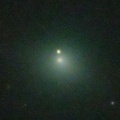
|
Now it is 8.7 mag (July 27, Marco Goiato). It will fade out rapidly after this. It will be unobservable in October.
Date(TT) R.A. (2000) Decl. Delta r Elong. m1 Best Time(A, h)
Aug. 5 15 49.40 -36 40.5 0.788 1.485 110 8.7 20:35 ( 21, 15)
Aug. 12 15 20.61 -29 14.1 0.986 1.492 96 9.2 20:25 ( 33, 17)
|
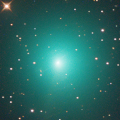
|
Now it is 9.4 mag (July 29, Osamu Miyazaki). It will fade out rapidly after this. It will be fainter than 18 mag in November. In the Northern Hemisphere, it stays observable in good condition. In the Southern Hemisphere, it is not observable now, but it will be observable soon.
Date(TT) R.A. (2000) Decl. Delta r Elong. m1 Best Time(A, h)
Aug. 5 21 10.87 60 38.3 0.414 1.174 102 9.5 0:18 (180, 64)
Aug. 12 21 31.65 48 46.1 0.384 1.231 116 9.8 0:12 (180, 75)
|

|
Now it is 9.8 mag (July 29, Marco Goiato). Fading slowly. In the Northern Hemisphere, it will be getting lower gradually. In the Southern Hemisphere, it stays observable in good condition.
Date(TT) R.A. (2000) Decl. Delta r Elong. m1 Best Time(A, h)
Aug. 5 3 9.21 3 28.7 2.293 2.447 86 9.7 3:35 (300, 41)
Aug. 12 3 5.40 0 10.1 2.184 2.480 94 9.6 3:43 (314, 45)
|

|
It is expected to brighten up to 7.5 mag in October. Now it is 13.1 mag (July 28, Osamu Miyazaki). Brightening rapidly. In the Northern Hemisphere, it stays observable in good condition. It locates somewhat low in the Southern Hemisphere. But it will become high in autumn. It is fainter than this ephemeris recently.
Date(TT) R.A. (2000) Decl. Delta r Elong. m1 Best Time(A, h)
Aug. 5 0 23.71 31 20.2 0.674 1.403 110 11.8 3:31 ( 0, 86)
Aug. 12 0 50.28 34 45.9 0.605 1.348 110 11.2 3:30 ( 0, 90)
|

|
It brightened up to 8 mag from 2022 summer to 2023 spring. Now it is 11 mag (July 15, Michael Mattiazzo). It stays 12 mag for a while. In the Northern Hemisphere, it is not observable now, but it will be observable soon. In the Southern Hemisphere, it will be getting higher gradually.
Date(TT) R.A. (2000) Decl. Delta r Elong. m1 Best Time(A, h)
Aug. 5 6 30.51 -8 53.0 3.912 3.271 44 11.6 3:35 (277, -6)
Aug. 12 6 35.21 -8 37.6 3.922 3.334 48 11.7 3:43 (281, 1)
|
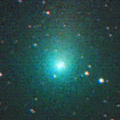
|
It brightened up to 9.5 mag from winter to early spring (Jan. 30, Katsumi Yoshimoto). Now it is 12.3 mag (July 29, Osamu Miyazaki). It will fade out rapidly after this. In the Northern Hemisphere, it stays observable in good condition. In the Southern Hemisphere, it will be getting higher gradually.
Date(TT) R.A. (2000) Decl. Delta r Elong. m1 Best Time(A, h)
Aug. 5 0 31.52 26 45.1 2.166 2.715 112 12.0 3:35 (352, 82)
Aug. 12 0 21.68 24 31.2 2.112 2.777 121 12.1 3:03 ( 0, 80)
|
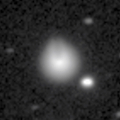
|
It returns for the first time in 70 years. It will brighten up to 4.5 mag in 2024 spring. It suddenly brightened in outburst by 5 mag up to 11.5 mag on July 20 (E. Tamas, Francois Kugel). Now it is 11.9 mag (July 29, Katsumi Yoshimoto). Fading slowly. In the Northern Hemisphere, it stays observable in good condition. In the Southern Hemisphere, it will be unobservable soon.
Date(TT) R.A. (2000) Decl. Delta r Elong. m1 Best Time(A, h)
Aug. 5 17 54.24 55 22.8 3.450 3.724 97 12.0 20:58 (180, 70)
Aug. 12 17 44.61 54 47.8 3.403 3.651 96 12.2 20:25 (178, 70)
|
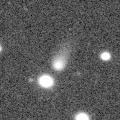
|
It is expected to brighten up to 7 mag in early 2024. Now it is 14.1 mag (June 19, Chris Wyatt). It will brighten rapidly after this. In the Northern Hemisphere, it is not observable now, but it will appear in November. It locates somewhat low in the Southern Hemisphere. But it will become high in winter. The brightness evolution slowed down since May.
Date(TT) R.A. (2000) Decl. Delta r Elong. m1 Best Time(A, h)
Aug. 5 8 0.34 -25 5.9 3.566 2.931 44 12.4 3:35 (280,-32)
Aug. 12 8 13.59 -25 43.1 3.491 2.857 44 12.3 3:43 (283,-28)
|

|
Now it is 13.7 mag (July 14, Chris Wyatt). It stays 13 mag for a while. In the Northern Hemisphere, it is not observable now, but it will appear in October. In the Southern Hemisphere, it will be unobservable soon. But it will be observable again in September.
Date(TT) R.A. (2000) Decl. Delta r Elong. m1 Best Time(A, h)
Aug. 5 10 25.82 -11 38.7 4.576 3.803 36 12.8 20:35 ( 89,-20)
Aug. 12 10 27.80 -12 37.1 4.645 3.823 31 12.8 20:25 ( 91,-23)
|
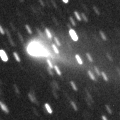
|
Now it is 12.6 mag (Aug. 5, Osamu Miyazaki). It will fade out rapidly after this. It will be fainter than 18 mag in December. It stays observable in good condition.
Date(TT) R.A. (2000) Decl. Delta r Elong. m1 Best Time(A, h)
Aug. 5 19 32.05 0 51.4 1.141 2.092 152 12.9 22:37 ( 0, 56)
Aug. 12 19 29.47 0 41.2 1.184 2.110 147 13.2 22:07 ( 0, 56)
|

|
Now it is 13.1 mag (July 22, Chris Wyatt). Fading slowly. In the Northern Hemisphere, it is not observable now. It was expected to brighten up to 10 mag from spring to summer. However, it is fainter than originally expected.
Date(TT) R.A. (2000) Decl. Delta r Elong. m1 Best Time(A, h)
Aug. 5 11 8.44 -79 10.3 2.888 3.191 97 13.0 20:35 ( 13,-35)
Aug. 12 11 11.81 -77 45.5 2.972 3.210 94 13.1 20:25 ( 15,-36)
|
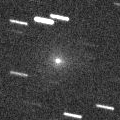
|
It was expected to brighten up to 11 mag in July. But actually, it is fainter than originally expected. Now it is 12.7 mag (July 15, Michael Mattiazzo). It will fade out rapidly after this. It will be fainter than 18 mag in October. It stays extremely low.
Date(TT) R.A. (2000) Decl. Delta r Elong. m1 Best Time(A, h)
Aug. 5 6 42.29 18 33.7 1.688 0.991 32 13.1 3:35 (253, 8)
Aug. 12 7 10.70 16 52.4 1.735 1.030 32 13.5 3:43 (255, 8)
|

|
It brightened up to 8.3 mag in 2021-2022 winter (Jan. 6, 2022, Toshiyuki Takahashi). Now it is 13.2 mag (July 14, Chris Wyatt). It stays 14 mag for a while. In the Northern Hemisphere, it is not observable now, but it will appear in November. It locates somewhat low in the Southern Hemisphere. But it will become high in autumn.
Date(TT) R.A. (2000) Decl. Delta r Elong. m1 Best Time(A, h)
Aug. 5 10 2.07 -31 34.4 6.656 6.071 51 13.2 20:35 ( 72,-34)
Aug. 12 10 7.82 -32 3.5 6.742 6.116 48 13.3 20:25 ( 73,-37)
|
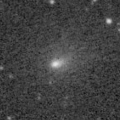
|
Now it is 14.0 mag (July 22, Thomas Lehmann). It will fade out rapidly after this. It will be fainter than 18 mag in November. In the Northern Hemisphere, it will be getting lower gradually. But it will be getting higher again after August. In the Southern Hemisphere, it will be getting higher gradually.
Date(TT) R.A. (2000) Decl. Delta r Elong. m1 Best Time(A, h)
Aug. 5 20 45.48 49 37.6 0.814 1.530 113 13.4 23:46 (180, 76)
Aug. 12 20 5.32 37 37.6 0.763 1.573 123 13.4 22:40 (180, 88)
|
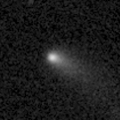
|
Now it is 13.8 mag (July 21, Ken-ichi Kadota). Fading gradually. In the Northern Hemisphere, it stays observable in good condition. In the Southern Hemisphere, it will be unobservable in September.
Date(TT) R.A. (2000) Decl. Delta r Elong. m1 Best Time(A, h)
Aug. 5 2 29.73 27 27.1 1.451 1.743 88 13.6 3:35 (278, 63)
Aug. 12 2 35.43 32 3.1 1.403 1.759 92 13.6 3:43 (272, 70)
|
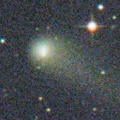
|
It brightened up to 11.1 mag in early 2022 (Mar. 31, 2022, F. Kugel, J.-G. Bosch, J. Nicolas). Now it is 13.0 mag (July 24, Osamu Miyazaki). Fading slowly. In the Northern Hemisphere, it stays observable in good condition. In the Southern Hemisphere, it will be getting lower gradually after this, and it will be unobservable in October.
Date(TT) R.A. (2000) Decl. Delta r Elong. m1 Best Time(A, h)
Aug. 5 15 15.47 20 24.4 5.396 5.456 88 13.9 20:35 ( 72, 57)
Aug. 12 15 17.65 19 59.8 5.517 5.491 83 14.0 20:25 ( 75, 54)
|
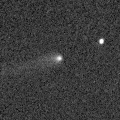
|
Now it is 14.6 mag (July 24, Toshihiko Ikemura, Hirohisa Sato). It stays 14 mag for a while. It stays observable in good condition.
Date(TT) R.A. (2000) Decl. Delta r Elong. m1 Best Time(A, h)
Aug. 5 2 20.53 7 24.6 3.026 3.301 96 14.1 3:35 (310, 52)
Aug. 12 2 12.19 7 36.5 2.901 3.315 105 14.0 3:43 (325, 58)
|

|
It stays 14 mag for a while. Now it is not observable. It will be observable soon.
Date(TT) R.A. (2000) Decl. Delta r Elong. m1 Best Time(A, h)
Aug. 5 7 50.64 23 50.7 7.086 6.123 17 14.2 3:35 (239, -2)
Aug. 12 7 56.14 23 33.4 7.050 6.126 22 14.1 3:43 (243, 3)
|

|
The ATLAS search program detected its cometary activity in April. It continues to be brightening even after the perihelion passage. Now it is 14.2 mag (July 24, Hidetaka Sato). Fading gradually. It locates somewhat low in the Northern Hemisphere. But it will become high in autumn. In the Southern Hemisphere, it stays observable in good condition.
Date(TT) R.A. (2000) Decl. Delta r Elong. m1 Best Time(A, h)
Aug. 5 0 1.40 -25 58.0 2.040 2.864 136 14.4 3:10 ( 0, 29)
Aug. 12 0 0.83 -26 24.2 2.022 2.889 141 14.4 2:42 ( 0, 29)
|

|
Now it is 14.3 mag (July 7, Thomas Lehmann). Fading slowly. In the Northern Hemisphere, it is not observable now. It locates somewhat low in the Southern Hemisphere. But it will become high in winter.
Date(TT) R.A. (2000) Decl. Delta r Elong. m1 Best Time(A, h)
Aug. 5 9 25.03 -45 25.4 2.614 2.334 62 14.4 20:35 ( 58,-45)
Aug. 12 9 51.54 -46 27.2 2.677 2.375 61 14.5 20:25 ( 56,-43)
|

|
It will brighten up to 7.5 mag in October. Now it is 14.4 mag (July 29, Katsumi Yoshimoto). Brightening rapidly. It will be unobservable in September in the Southern Hemisphere, or in October in the Northern Hemisphere.
Date(TT) R.A. (2000) Decl. Delta r Elong. m1 Best Time(A, h)
Aug. 5 4 3.79 29 35.2 1.599 1.533 67 15.5 3:35 (261, 45)
Aug. 12 4 29.58 31 7.7 1.458 1.439 68 14.6 3:43 (260, 47)
|

|
It approached to Earth down to 0.29 a.u. in early February, and it brightened up to 4.5 mag (Feb. 1, Juan Jose Gonzalez). Now it is 14.3 mag (July 18, Hidetaka Sato). Fading slowly. In the Northern Hemisphere, it is not observable now, but it will appear in September. In the Southern Hemisphere, it stays observable in good condition.
Date(TT) R.A. (2000) Decl. Delta r Elong. m1 Best Time(A, h)
Aug. 5 6 28.88 -29 30.9 3.482 3.084 58 14.6 3:35 (295,-17)
Aug. 12 6 32.48 -31 34.1 3.501 3.161 62 14.7 3:43 (300,-12)
|

|
Now it is 14.8 mag (July 17, Toshihiko Ikemura, Hirohisa Sato). It stays 15 mag for a while. It will be getting lower gradually after this, and it will be unobservable in October. But it will be observable again in December in the Northern Hemisphere. It is expected to brighten up to 12.5 mag in 2024 spring. At the high light, it will be observable in excellent condition in the Southern Hemisphere, but it will be low in the Northern Hemisphere.
Date(TT) R.A. (2000) Decl. Delta r Elong. m1 Best Time(A, h)
Aug. 5 15 29.41 12 24.4 3.296 3.511 93 14.7 20:35 ( 58, 54)
Aug. 12 15 23.07 10 40.4 3.372 3.467 86 14.7 20:25 ( 62, 49)
|
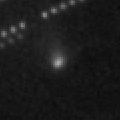
|
It brightened very rapidly. Now it is 14.9 mag (July 13, Taras Prystavski). It will fade out rapidly after this. In the Northern Hemisphere, it is not observable now, but it will appear in November. In the Southern Hemisphere, it will be getting lower gradually after this, and it will be unobservable in October.
Date(TT) R.A. (2000) Decl. Delta r Elong. m1 Best Time(A, h)
Aug. 5 13 52.02 -42 3.8 1.818 2.079 89 14.7 20:35 ( 37, -2)
Aug. 12 13 51.70 -37 21.4 1.950 2.065 81 14.7 20:25 ( 43, -1)
|

|
Now it is 14.5 mag (July 17, L. Grazzini). Fading slowly. It locates somewhat low in the Northern Hemisphere. In the Southern Hemisphere, it stays observable in good condition.
Date(TT) R.A. (2000) Decl. Delta r Elong. m1 Best Time(A, h)
Aug. 5 17 53.36 -29 56.3 2.093 2.910 136 14.7 20:59 ( 0, 25)
Aug. 12 17 52.71 -30 41.1 2.161 2.910 129 14.8 20:31 ( 0, 24)
|

|
It will approach to Sun down to 0.05 a.u. on Aug. 21, and it will brighten up to 5.5 mag. It will turn to fade out rapidly after brightening. It will be fainter than 18 mag in September. In the Northern Hemisphere, it will never be observable after this. In the Southern Hemisphere, it will be unobservable soon.
Date(TT) R.A. (2000) Decl. Delta r Elong. m1 Best Time(A, h)
Aug. 5 11 8.81 -4 6.5 0.821 0.635 38 16.5 20:35 ( 90, -7)
Aug. 12 10 45.29 1 35.7 0.827 0.425 24 14.8 20:25 (101,-12)
|

|
Now it is 14.5 mag (July 24, Toshihiko Ikemura, Hirohisa Sato). Fading gradually. In the Southern Hemisphere, it stays observable in good condition.
Date(TT) R.A. (2000) Decl. Delta r Elong. m1 Best Time(A, h)
Aug. 5 16 57.58 -19 42.1 1.918 2.616 123 14.8 20:35 ( 9, 35)
Aug. 12 17 0.20 -19 58.8 2.036 2.657 117 15.0 20:25 ( 13, 34)
|
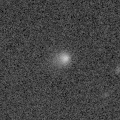
|
Now it is 15.6 mag (July 8, Thomas Lehmann). Brightening slowly. Now it is not observable. It will appear in September. It is expected to brighten up to 12 mag from 2024 to 2025.
Date(TT) R.A. (2000) Decl. Delta r Elong. m1 Best Time(A, h)
Aug. 5 9 15.09 2 54.5 6.064 5.090 14 14.9 20:35 (113,-25)
Aug. 12 9 18.11 3 7.2 6.037 5.051 12 14.9 3:43 (246,-25)
|
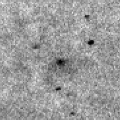
|
It brightened up to 12.8 mag in spring (Mar. 8, Taras Prystavski). Now it is 15.5 mag (July 23, Thomas Lehmann). Fading gradually. It will be fainter than 18 mag in December. It stays observable in good condition.
Date(TT) R.A. (2000) Decl. Delta r Elong. m1 Best Time(A, h)
Aug. 5 1 33.68 -2 9.8 1.769 2.330 110 15.2 3:35 (334, 50)
Aug. 12 1 34.87 -2 18.4 1.729 2.369 117 15.3 3:43 (347, 52)
|

|
It will brighten up to 14 mag from 2024 to 2025. Now it is 15.2 mag (July 22, ATLAS Chile). It stays 15 mag for a while. In the Northern Hemisphere, it is not observable now, but it will appear in October. It stays extremely low in the Southern Hemisphere. But it will become high in autumn.
Date(TT) R.A. (2000) Decl. Delta r Elong. m1 Best Time(A, h)
Aug. 5 9 58.93 -26 52.2 6.493 5.841 46 15.2 20:35 ( 78,-33)
Aug. 12 10 5.77 -26 59.1 6.509 5.814 43 15.2 20:25 ( 79,-35)
|

|
It has not been observed yet in this apparition. It was expected to brighten rapidly up to 15 mag in summer. But actually, it is not detected, fainter than 18.5 mag (July 18, Martin Masek). It stays 16 mag for a while. It locates somewhat low in the Northern Hemisphere. In the Southern Hemisphere, it stays observable in good condition.
Date(TT) R.A. (2000) Decl. Delta r Elong. m1 Best Time(A, h)
Aug. 5 16 45.41 -31 4.6 1.406 2.120 121 15.3 20:35 ( 10, 23)
Aug. 12 16 49.97 -30 15.8 1.452 2.102 115 15.3 20:25 ( 13, 23)
|
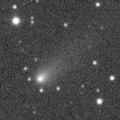
|
Now it is 15.1 mag (July 22, Thomas Lehmann). Fading gradually. It will be fainter than 18 mag in December. In the Northern Hemisphere, it will be unobservable in September. In the Southern Hemisphere, it stays observable in good condition.
Date(TT) R.A. (2000) Decl. Delta r Elong. m1 Best Time(A, h)
Aug. 5 14 3.15 -35 25.7 2.282 2.486 89 15.7 20:35 ( 40, 5)
Aug. 12 14 13.20 -35 59.1 2.374 2.500 85 15.8 20:25 ( 40, 3)
|

|
Now it is 15.7 mag (July 16, Hiroshi Abe). It stays 16 mag for a while. It stays observable in good condition.
Date(TT) R.A. (2000) Decl. Delta r Elong. m1 Best Time(A, h)
Aug. 5 0 49.45 -5 4.0 2.910 3.555 122 15.8 3:35 (351, 50)
Aug. 12 0 48.96 -5 18.1 2.845 3.570 128 15.8 3:30 ( 0, 50)
|

|
It will approach to Sun down to 0.4 a.u. in late September in 2024, and it is expected to brighten up to 0 mag. Now it is 16.1 mag (July 28, ATLAS Chile). Brightening slowly. It will be getting lower gradually after this, and it will be unobservable in October. But it will be observable again in November in the Northern Hemisphere. At the high light, in the Northern Hemisphere, it will be observable in good condition after the perihelion passage. In the Southern Hemisphere, it will be observable in the low sky before and after the perihelion passage.
Date(TT) R.A. (2000) Decl. Delta r Elong. m1 Best Time(A, h)
Aug. 5 14 3.10 1 49.1 5.958 5.804 76 16.0 20:35 ( 67, 32)
Aug. 12 14 2.98 1 26.0 6.003 5.735 69 16.0 20:25 ( 70, 28)
|
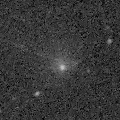
|
Very large comet. It is expected to brighten up to 13 mag in 2031. Now it is 15.9 mag (July 23, Thomas Lehmann). It stays 16 mag for a while. In the Northern Hemisphere, it is not observable now. In the Southern Hemisphere, it stays observable in good condition. In the Northern Hemisphere, it is not observable until 2030.
Date(TT) R.A. (2000) Decl. Delta r Elong. m1 Best Time(A, h)
Aug. 5 3 31.22 -60 44.3 17.155 17.376 100 16.4 3:35 (339,-13)
Aug. 12 3 32.42 -61 11.8 17.106 17.351 102 16.3 3:43 (343,-11)
|

|
Now it is 16.2 mag (July 28, ATLAS Chile). Fading gradually. It will be fainter than 18 mag in October. It stays observable in good condition. It was very faint as 21.5 mag in 2021. It seems to be bright temporarily in outburst.
Date(TT) R.A. (2000) Decl. Delta r Elong. m1 Best Time(A, h)
Aug. 5 21 30.38 -10 41.6 3.451 4.453 169 16.6 0:40 ( 0, 44)
Aug. 12 21 26.47 -10 52.5 3.455 4.467 175 16.7 0:08 ( 0, 44)
|
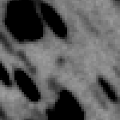
|
Now it is 16.7 mag (July 20, Taras Prystavski). It stays 17 mag for a while. It stays observable in good condition.
Date(TT) R.A. (2000) Decl. Delta r Elong. m1 Best Time(A, h)
Aug. 5 17 42.57 -10 31.4 1.874 2.664 132 16.6 20:48 ( 0, 44)
Aug. 12 17 41.93 -10 38.2 1.921 2.644 125 16.6 20:25 ( 2, 44)
|

|
It brightened up to 13.4 mag in last summer (July 7, 2022, Giuseppe Pappa). Now it is 16.3 mag (July 17, Toshihiko Ikemura, Hirohisa Sato). Fading slowly. In the Northern Hemisphere, it stays observable in good condition. In the Southern Hemisphere, it will be unobservable in October.
Date(TT) R.A. (2000) Decl. Delta r Elong. m1 Best Time(A, h)
Aug. 5 15 23.97 32 51.5 4.238 4.289 86 16.6 20:35 ( 94, 64)
Aug. 12 15 21.48 32 23.2 4.372 4.335 81 16.7 20:25 ( 95, 60)
|

|
Very far object. Now it is 17.3 mag (July 23, ATLAS South Africa). It stays 17 mag for a while. In the Northern Hemisphere, it is not observable now. In the Southern Hemisphere, it stays observable in good condition.
Date(TT) R.A. (2000) Decl. Delta r Elong. m1 Best Time(A, h)
Aug. 5 5 46.17 -69 18.1 10.227 10.327 92 16.8 3:35 (337,-29)
Aug. 12 5 47.85 -69 50.9 10.223 10.326 92 16.8 3:43 (339,-27)
|

|
It is expected to brighten up to 14 mag in winter. Now it is 17.8 mag (July 6, John Maikner). Brightening gradually. It stays observable in good condition.
Date(TT) R.A. (2000) Decl. Delta r Elong. m1 Best Time(A, h)
Aug. 5 2 59.93 11 51.7 2.857 2.965 86 16.9 3:35 (294, 48)
Aug. 12 3 6.46 12 23.3 2.728 2.928 91 16.8 3:43 (301, 54)
|

|
It brightened up to 14.1 mag in 2022 spring (Mar. 22, 2022, Chris Wyatt). It was expected to brighten up to 13 mag. But actually, it was fainter than originally expected. Now it is 16.3 mag (July 21, Ken-ichi Kadota). It stays 17 mag for a while. It stays observable in good condition.
Date(TT) R.A. (2000) Decl. Delta r Elong. m1 Best Time(A, h)
Aug. 5 3 5.29 -2 46.6 4.849 4.938 89 16.9 3:35 (307, 37)
Aug. 12 3 3.55 -2 40.1 4.779 4.984 95 16.9 3:43 (316, 43)
|

|
It is expected to brighten up to 14 mag in 2024 summer. At the high light, it is not observable in the Northern Hemisphere. Now it is 18.2 mag (July 15, ATLAS Chile). Brightening slowly. It stays observable in good condition.
Date(TT) R.A. (2000) Decl. Delta r Elong. m1 Best Time(A, h)
Aug. 5 3 28.09 5 34.4 4.442 4.402 81 17.2 3:35 (294, 39)
Aug. 12 3 29.98 4 27.2 4.277 4.353 87 17.0 3:43 (303, 44)
|

|
Now it is 16.8 mag (July 31, Giuseppe Pappa). It stays 17 mag for a while. It will be unobservable in October in the Northern Hemisphere, or in December in the Southern Hemisphere. It stays 16 mag in the Southern sky for a long time from 2024 to 2025.
Date(TT) R.A. (2000) Decl. Delta r Elong. m1 Best Time(A, h)
Aug. 5 16 46.46 -40 51.6 5.997 6.585 121 17.1 20:35 ( 8, 13)
Aug. 12 16 40.86 -40 40.1 6.073 6.554 114 17.1 20:25 ( 13, 13)
|
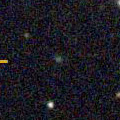
|
Now it is 17.4 mag (Feb. 16, Toshihiko Ikemura, Hirohisa Sato). It stays 17 mag for a while. In the Northern Hemisphere, it stays observable in good condition. It stays extremely low in the Southern Hemisphere.
Date(TT) R.A. (2000) Decl. Delta r Elong. m1 Best Time(A, h)
Aug. 5 4 37.24 36 28.8 7.209 6.761 60 17.2 3:35 (249, 40)
Aug. 12 4 41.76 36 52.9 7.109 6.755 65 17.2 3:43 (251, 46)
|

|
It returns for the first time in 68 years. It will brighten up to 7.5 mag in 2024 summer. It has not been observed yet in this apparition. It will brighten rapidly after this. In the Northern Hemisphere, it will be getting higher gradually. In the Southern Hemisphere, it stays observable in good condition. At the high light, it locates low in the Northern Hemisphere, or it is not observable in the Southern Hemisphere.
Date(TT) R.A. (2000) Decl. Delta r Elong. m1 Best Time(A, h)
Aug. 5 4 9.19 -14 0.6 4.289 4.192 77 17.5 3:35 (303, 18)
Aug. 12 4 13.58 -14 16.8 4.139 4.127 82 17.3 3:43 (309, 23)
|

|
Now it is 17.4 mag (July 25, ATLAS Chile). It stays 17 mag for a while. In the Northern Hemisphere, it will be getting higher gradually. In the Southern Hemisphere, it stays observable in good condition.
Date(TT) R.A. (2000) Decl. Delta r Elong. m1 Best Time(A, h)
Aug. 5 4 45.02 -9 7.4 8.059 7.733 67 17.4 3:35 (293, 15)
Aug. 12 4 47.98 -9 16.9 7.939 7.700 72 17.4 3:43 (298, 21)
|
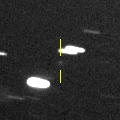
|
First return of a new periodic comet which brightened up to 15 mag in 2008. Now it is 17.7 mag (July 25, J. L. Virlichie, P. Traverse, H. Roy). Fading slowly. It will be fainter than 18 mag in November. It stays observable in good condition.
Date(TT) R.A. (2000) Decl. Delta r Elong. m1 Best Time(A, h)
Aug. 5 3 21.18 22 33.6 2.447 2.452 78 17.4 3:35 (276, 50)
Aug. 12 3 30.80 22 15.2 2.382 2.471 82 17.4 3:43 (281, 55)
|

|
It approached to Earth down to 0.12 a.u. in April, and brightened up to 11.5 mag (Apr. 8, Osamu Miyazaki). Now it is 15.6 mag (July 16, Ken-ichi Kadota). Fading rapidly. It will be fainter than 18 mag soon. It stays observable in good condition.
Date(TT) R.A. (2000) Decl. Delta r Elong. m1 Best Time(A, h)
Aug. 5 2 40.65 0 18.9 0.983 1.461 94 17.4 3:35 (311, 43)
Aug. 12 2 40.94 0 21.7 0.983 1.535 100 17.8 3:43 (321, 48)
|

|
Now it is 17.5 mag (July 26, Ken-ichi Kadota). It stays 18 mag for a while. In the Northern Hemisphere, it stays observable in good condition. It stays extremely low in the Southern Hemisphere.
Date(TT) R.A. (2000) Decl. Delta r Elong. m1 Best Time(A, h)
Aug. 5 14 12.60 38 44.4 3.072 2.898 70 17.5 20:35 (110, 51)
Aug. 12 14 23.09 36 44.8 3.108 2.900 68 17.5 20:25 (107, 49)
|

|
It brightened up to 13.6 mag in 2021 (June 17, 2021, R. Carstens). Now it is 17.3 mag (June 9, D. Husar, M. Junius, S. Messner). It stays 18 mag for a while. In the Northern Hemisphere, it will never be observable after this. In the Southern Hemisphere, it will be getting lower gradually.
Date(TT) R.A. (2000) Decl. Delta r Elong. m1 Best Time(A, h)
Aug. 5 11 6.50 -60 38.4 6.974 6.906 82 17.7 20:35 ( 35,-33)
Aug. 12 11 9.32 -60 19.1 7.073 6.941 78 17.7 20:25 ( 36,-34)
|

|
Now it is 17.9 mag (July 16, Toshihiko Ikemura, Hirohisa Sato). It stays 18 mag for a while. It stays observable in good condition.
Date(TT) R.A. (2000) Decl. Delta r Elong. m1 Best Time(A, h)
Aug. 5 3 26.91 9 1.4 2.978 2.983 80 17.8 3:35 (291, 42)
Aug. 12 3 33.83 9 3.1 2.896 2.991 85 17.7 3:43 (298, 47)
|
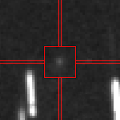
|
Now it is 18.0 mag (July 28, Ken-ichi Kadota). It stays 18 mag for a while. It stays observable in good condition.
Date(TT) R.A. (2000) Decl. Delta r Elong. m1 Best Time(A, h)
Aug. 5 23 11.01 -11 52.9 2.134 3.038 147 17.9 2:20 ( 0, 43)
Aug. 12 23 8.96 -12 51.4 2.093 3.040 154 17.8 1:50 ( 0, 42)
|

|
Now it is 17.8 mag (July 16, Yasukazu Ikari). It stays 18 mag for a while. In the Northern Hemisphere, it stays observable in good condition. In the Southern Hemisphere, it will never be observable after this.
Date(TT) R.A. (2000) Decl. Delta r Elong. m1 Best Time(A, h)
Aug. 5 14 39.99 77 11.1 10.420 10.157 72 17.9 20:35 (168, 44)
Aug. 12 14 36.21 76 35.3 10.437 10.177 72 17.9 20:25 (166, 43)
|

|
It has not been observed yet in this apparition. It tends to brighten after the perihelion passage. Brightening gradually. In the Northern Hemisphere, it is not observable now. In the Southern Hemisphere, it will be unobservable in October.
Date(TT) R.A. (2000) Decl. Delta r Elong. m1 Best Time(A, h)
Aug. 5 10 45.59 8 20.4 2.198 1.382 27 18.8 20:35 (103, -4)
Aug. 12 11 7.75 6 25.3 2.193 1.367 26 18.4 20:25 (101, -4)
|
|
![]()
 81P/Wild 2
81P/Wild 2 C/2022 E2 ( ATLAS )
C/2022 E2 ( ATLAS ) 71P/Clark
71P/Clark C/2021 G2 ( ATLAS )
C/2021 G2 ( ATLAS ) 213P/Van Ness
213P/Van Ness 77P/Longmore
77P/Longmore 117P/Helin-Roman-Alu 1
117P/Helin-Roman-Alu 1 C/2023 A3 ( Tsuchinshan-ATLAS )
C/2023 A3 ( Tsuchinshan-ATLAS ) C/2014 UN271 ( Bernardinelli-Bernstein )
C/2014 UN271 ( Bernardinelli-Bernstein ) P/2023 M4 ( ATLAS )
P/2023 M4 ( ATLAS ) 219P/LINEAR
219P/LINEAR C/2020 R7 ( ATLAS )
C/2020 R7 ( ATLAS ) C/2019 E3 ( ATLAS )
C/2019 E3 ( ATLAS ) 32P/Comas Sola
32P/Comas Sola C/2020 Y2 ( ATLAS )
C/2020 Y2 ( ATLAS ) C/2022 S4 ( Lemmon )
C/2022 S4 ( Lemmon ) C/2023 F3 ( ATLAS )
C/2023 F3 ( ATLAS ) C/2021 S4 ( Tsuchinshan )
C/2021 S4 ( Tsuchinshan ) 13P/Olbers
13P/Olbers C/2022 QE78 ( ATLAS )
C/2022 QE78 ( ATLAS ) 465P/2023 L1 ( Hill )
465P/2023 L1 ( Hill ) 364P/PanSTARRS
364P/PanSTARRS C/2022 U4 ( Bok )
C/2022 U4 ( Bok ) C/2018 U1 ( Lemmon )
C/2018 U1 ( Lemmon ) 170P/Christensen
170P/Christensen 287P/Christensen
287P/Christensen C/2019 O3 ( Palomar )
C/2019 O3 ( Palomar ) 339P/Gibbs
339P/Gibbs![]()














































